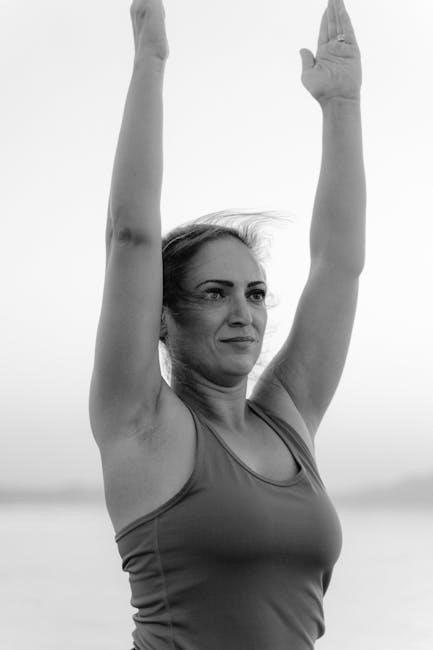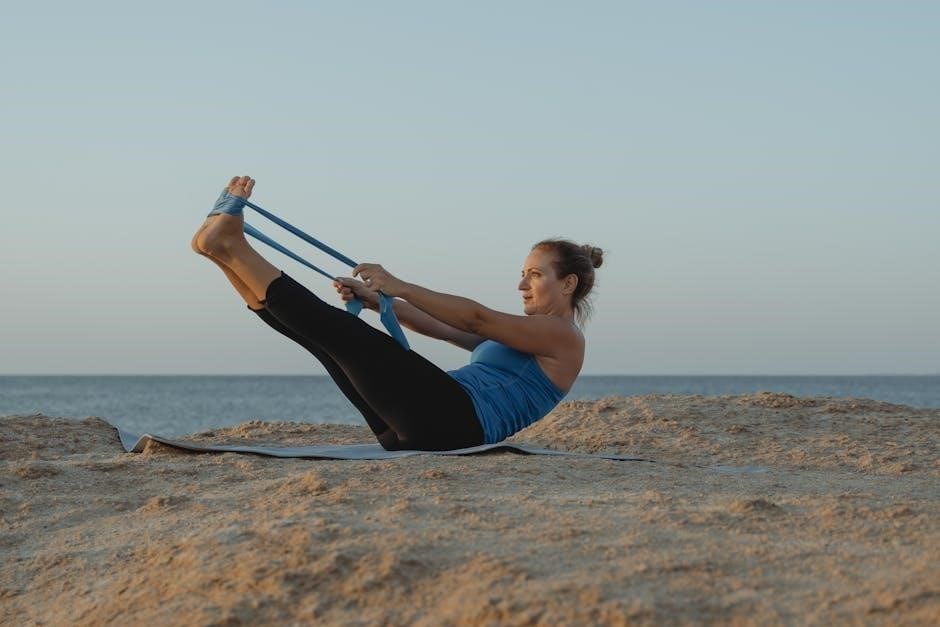scapular exercises pdf
The scapula plays a vital role in shoulder movement and stability, making it essential for overall upper body function. Scapular exercises, such as retractions and stabilizations, help improve posture, reduce injury risk, and enhance athletic performance. Regular practice strengthens the muscles around the shoulder blade, promoting better mobility and balance.
1.1 The Role of the Scapula in Shoulder Movement
The scapula, or shoulder blade, is a critical component of the shoulder complex, enabling a wide range of movements such as abduction, rotation, and elevation. Its primary function is to stabilize the humerus (upper arm bone) and provide a platform for shoulder joint mobility; The scapula works in conjunction with the clavicle (collarbone) and humerus to facilitate smooth, coordinated movements. During actions like overhead reaching or throwing, the scapula rotates and tilts to accommodate the humerus, ensuring proper alignment and reducing stress on the joint.
The scapula’s movement is closely linked to the concept of scapulohumeral rhythm, where the scapula and humerus move in harmony. This synchronization is essential for efficient and injury-free shoulder function. Weakness or dysfunction in the scapular muscles can disrupt this rhythm, leading to poor mechanics and increased risk of injury. Strengthening the scapular muscles, such as the trapezius, rhomboids, and serratus anterior, is vital for maintaining optimal shoulder movement and overall upper body performance.
- The scapula acts as a stabilizer during shoulder movements.
- It facilitates proper alignment of the humerus in the shoulder socket.
- Scapular dysfunction can lead to shoulder impingement and injury.

Importance of Scapular Strengthening
Strengthening the scapula is vital for preventing injuries, improving posture, and enhancing shoulder function. It stabilizes the joint, ensures proper movement, and reduces impingement risk, boosting athletic performance and improving daily activities.
2.1 Preventing Shoulder Impingement and Injury
Shoulder impingement occurs when the shoulder blade doesn’t move properly, causing the shoulder joint to get pinched. Strengthening the muscles around the scapula can help maintain proper positioning and reduce this risk. Exercises like prone scapular retractions, where you lie on your stomach and squeeze your shoulder blades together, and wall slides, where you stand with your hands on a wall and slide your arms up while keeping your shoulders down, are particularly effective. These exercises improve scapular stability and positioning. It’s important to start without weights and gradually add resistance as the exercises become easier. Performing 3 sets of 10 repetitions is a good starting point. Maintaining proper form, such as keeping your back straight and avoiding shrugging your shoulders, ensures the exercises target the right muscles and prevent further injury. Consistently performing these exercises with controlled movements can help stabilize the shoulder joint and reduce the risk of impingement.

Types of Scapular Exercises
Scapular exercises include dynamic and isometric movements. Dynamic exercises, like arm raises and wall slides, involve movement to improve mobility. Isometric exercises, such as shoulder blade squeezes, strengthen muscles without movement. Both types enhance stability and strength.
3.1 Dynamic and Isometric Exercises for Scapular Stability
Dynamic exercises, such as arm circles and wall slides, involve movement to enhance scapular mobility and strength. These exercises require controlled arm movements while maintaining proper shoulder blade positioning. Isometric exercises, like the prone scapular retraction, involve holding static positions to build endurance. Both types improve stability and reduce injury risk.

Designing a Scapular Exercise Program
A well-rounded program should include 3 sets of 10-15 repetitions for each exercise, focusing on both dynamic and isometric movements. Start with lighter weights and gradually increase resistance as strength improves. Aim for 1-2 sessions daily, 5 times weekly.
4.1 Creating a Balanced Routine with Sets and Repetitions
A balanced scapular routine involves structuring exercises with specific sets and repetitions to ensure effectiveness. Start with 3 sets of 10-15 repetitions for each exercise, allowing adequate recovery time between sets. This approach helps build both strength and endurance. As progress is made, gradually increase resistance by adding 1-2 pounds to each hand or using resistance bands. For dynamic exercises like scapular retractions and arm raises, focus on controlled movements to maximize muscle engagement. Isometric exercises, such as wall slides and shoulder blade squeezes, should be held for 2-3 seconds to enhance stability. Consistency is key; aim to perform these exercises 1-2 times daily, 5 times a week. Proper form is essential to avoid injury and ensure the muscles are targeted effectively. Over time, as strength improves, the intensity can be increased by modifying the exercises or incorporating more advanced techniques.

Progressing Your Scapular Workout
As strength improves, progress your routine by adding resistance, increasing repetitions, or introducing advanced techniques like single-arm exercises or dynamic movements. Incorporate variations to challenge scapular stability and endurance, ensuring continued growth and adaptation.
5.1 Advanced Techniques and Resistance Training
For those seeking to enhance their scapular workout, advanced techniques and resistance training offer a pathway to greater strength and stability. Incorporating resistance bands or dumbbells can intensify exercises like single-arm scapular retractions or prone thumb-up abductions, targeting specific muscle groups. Progressive overload, gradually increasing weight or resistance, is key to continuous improvement. Additionally, modifying exercises by changing the angle or range of motion can add variety and challenge. For instance, performing exercises on unstable surfaces or incorporating dynamic movements can elevate the difficulty. It’s crucial to maintain proper form throughout each exercise to ensure effectiveness and prevent injury. Advanced techniques not only build resilience but also enhance overall shoulder function, making them particularly beneficial for athletes or individuals recovering from shoulder-related issues.
